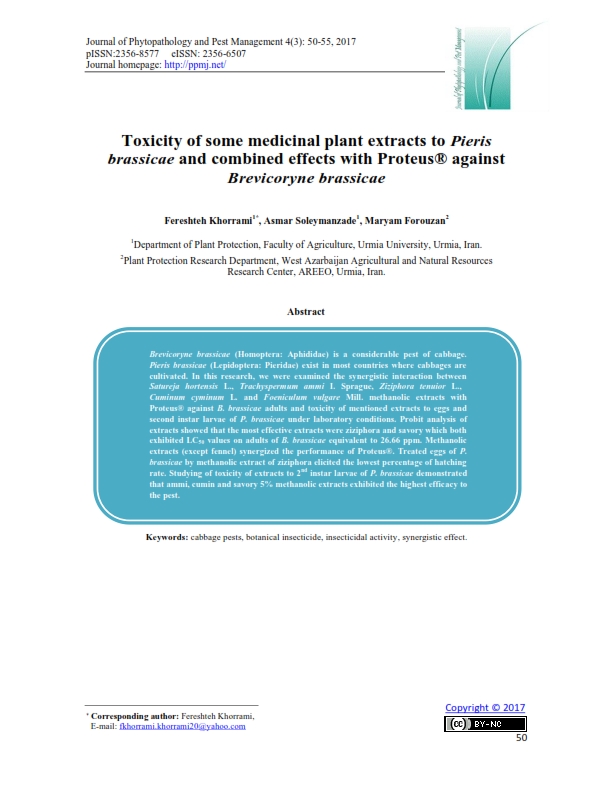Toxicity of some medicinal plant extracts to Pieris brassicae and combined effects with Proteus® against Brevicoryne brassicae
Keywords:
cabbage pests, botanical insecticide, insecticidal activity, synergistic effectAbstract
Brevicoryne brassicae (Homoptera: Aphididae) is a considerable pest of cabbage. Pieris brassicae (Lepidoptera: Pieridae) exist in most countries where cabbages are cultivated. In this research, we were examined the synergistic interaction between Satureja hortensis L., Trachyspermum ammi I. Sprague, Ziziphora tenuior L., Cuminum cyminum L. and Foeniculum vulgare Mill. methanolic extracts with Proteus® against B. brassicae adults and toxicity of mentioned extracts to eggs and second instar larvae of P. brassicae under laboratory conditions. Probit analysis of extracts showed that the most effective extracts were ziziphora and savory which both exhibited LC50 values on adults of B. brassicae equivalent to 26.66 ppm. Methanolic extracts (except fennel) synergized the performance of Proteus®. Treated eggs of P. brassicae by methanolic extract of ziziphora elicited the lowest percentage of hatching rate. Studying of toxicity of extracts to 2nd instar larvae of P. brassicae demonstrated that ammi, cumin and savory 5% methanolic extracts exhibited the highest efficacy to the pest.
Metrics

Published
How to Cite
Issue
Section
License
Authors who publish with Journal of Phytopathology and Disease Management agree to the following terms:
- Authors retain copyright and grant the journal right of first publication with the work simultaneously licensed under a Creative Commons Attribution License that allows others to share the work with an acknowledgement of the work's authorship and initial publication in this journal.
- Authors retain copyright and grant the journal right of first publication with the work simultaneously licensed under the Creative Commons Attribution-Non Commercial License (CC BY-NC). This allows others to share the work with an acknowledgement of the work's authorship and initial publication in this journal.
- Archives of Agricultural Sciences Journal is an Open Access Journal, and articles published are distributed under the terms of the Creative Commons Attribution-Non Commercial License (CC BY-NC). Readers may copy, distribute, and display the work for non commercial purposes with the proper citation of the original work. However, the journal retains the right to exploit subsidiary rights on behalf of the authors.
- Authors are able to enter into separate, additional contractural arrangements for the non-exclusive distribution of the journal's published version of the work (e.g. post it to an institutional repository or publish it in a book), with an acknowledgement of its initial publication in this journal.
- Authors are permitted and encouraged to post their work online (e.g., in institutional repositories or on their website) prior to and during the submission process with full disclosure to the journal, as it can lead to productive exchanges, as well as earlier and greater citation of published work. Following publication in Archives of Agricultural Sciences Journal, the author should update the repository, and include a citation and link to the published work.
Click here for more information on Licensing policy
.png)




